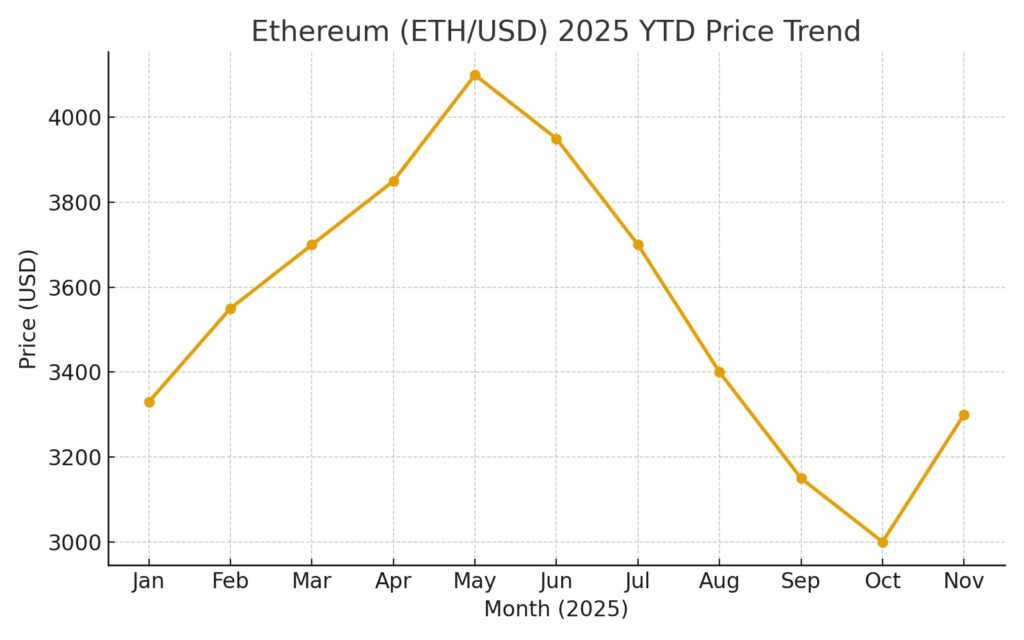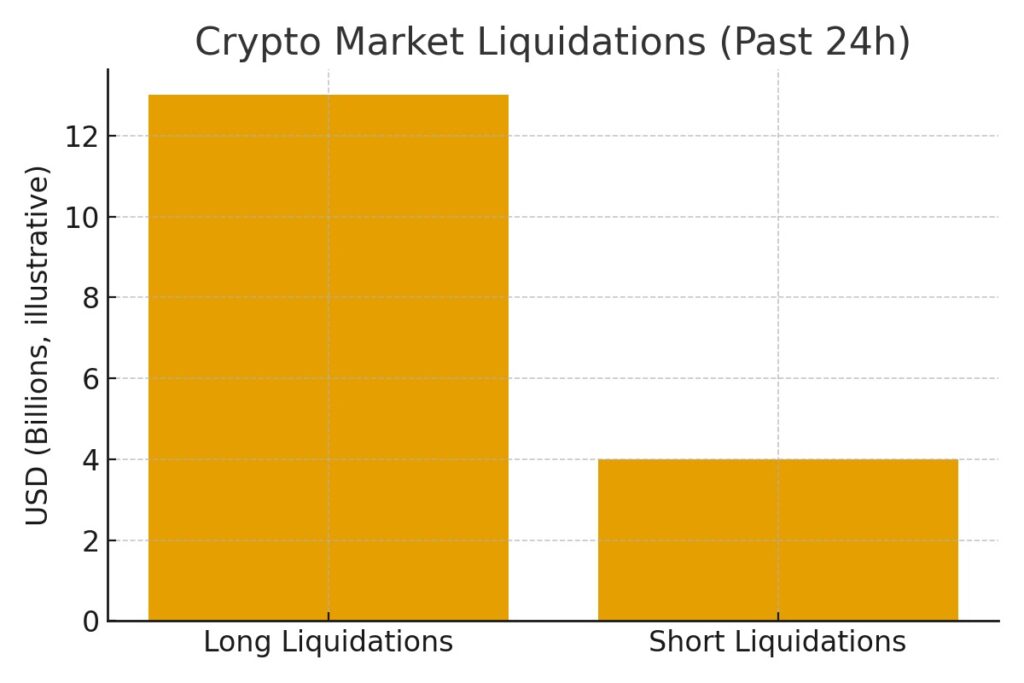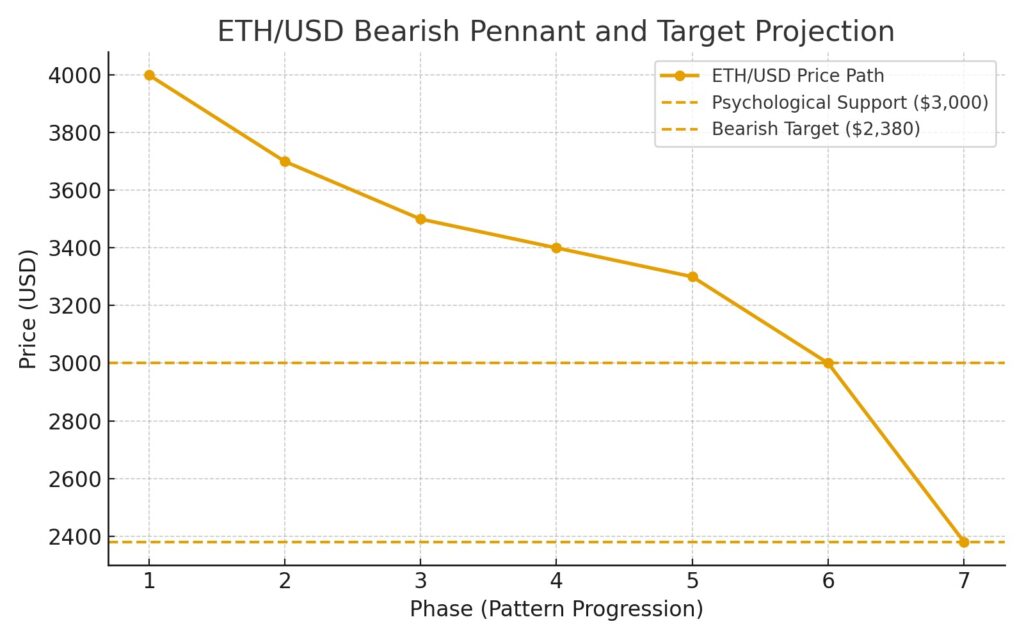
Main Points :
- Ethereum (ETH) fell toward the psychological $3,000 mark, wiping out its year-to-date gains.
- A cascade of leveraged long liquidations and broader market stress triggered the drop.
- Technically, the break of key support opens the possibility of a further leg down toward ~$2,380, though oversold indicators hint at possible relief.
- Underlying fundamentals (staking growth, DeFi activity, institutional interest) still present a structural case for ETH — but short-term risk is elevated.
- For new crypto asset hunters and practitioners of blockchain use-cases, this juncture raises both opportunity (cheap ruble on exit risk) and caution (end of bull phase risk) alike.
1. The Drop That Shook the Altcoin Market

Ethereum, the second-largest cryptocurrency by market cap, found itself plunging toward the $3,000 level, a psychologically and technically important threshold. According to recent data, ETH had declined by as much as ~16 % in short order to around $3,050, before rebounding toward ~$3,300.
That drop is significant: it erased almost all of the gains ETH had posted earlier in the year. At the beginning of the year, ETH opened around $3,330, and the fall to around $3,300 means the ascent since January has been completely undone.
What triggered this? A couple of drivers:
- A massive liquidation event of leveraged longs in the crypto derivatives market. For example, one report shows over $4.848 billion of long ETH positions liquidated in just one 24-hour span.
- Technical support breaks: ETH broke beneath major moving averages and consolidation zones, which turned bullish supports into resistance.
- Macro-environmental pressure: The broader crypto market lost over $1 trillion in capitalization since early October, with ETH, Bitcoin, and other major tokens all showing steep losses simultaneously.
In short: ETH’s rapid descent is not just an altcoin hiccup—it’s a broad correction amplified by leverage, macro risk, and structural technical breakdowns.
2. Technical Landscape: Support, Breakdown, and the $2,380 Warning

In chart-terms, important patterns emerged. ETH formed what analysts call a bearish pennant (a consolidation after an upward move) which, when its lower boundary is breached, tends to precede continued downward movement.
Key technical thresholds:
- Short-term support around ~$3,300 is being retested. A break below this would be a warning of trend extension downward.
- If that fails, the “measured move” target becomes approximately $2,380, equal to the April 2025 lows and drawn from the pennant structure.
- On the upside, a crossover back above ~$3,800-$3,900 would be needed to invalidate the bearish structure and signal a potential recovery.
At the same time some momentum indicators show oversold conditions: the RSI (Relative Strength Index) rebounded from low teens to around ~33, indicating that there may be short-term relief rallies.
For the practitioner looking at new assets or blockchain use-cases, the takeaway is: while the fundamentals remain interesting, the timing matters. The technical environment currently suggests caution for chasing new entries before a stability signal emerges.

3. Market Fundamentals: Still Intact — But Not Bullish Free-Ride
Despite the short-term pain, ETH’s longer-term fundamental story remains compelling in several respects:
- Staking and Protocol Usage: The shift to proof-of-stake and the rewards for validators continue to absorb supply of ETH and reinforce network relevance. For example, a recent article noted high staking participation and robust network usage during the drop.
- Institutional Adoption & ETF Flows: Some reports indicate that due to Ethereum-based ETFs and other institutional mechanisms, ETH is gaining a firmer foothold in the “traditional finance meets crypto” world.
- Real-world Use Cases: With DeFi, tokenization, and layered roll-ups driving network activity, the utility dimension of ETH remains strong — meaning its value proposition isn’t purely speculative.
Nevertheless, there are caveats:
- Macro headwinds (interest rates, regulatory risk, broader risk-off mentality) are dampening investor appetite for risk assets including altcoins.
- The competition from alternative blockchains (Layer 1s and Layer 2s) continues to challenge Ethereum’s dominance.
- Sentiment can move faster than the fundamentals; just because the long-term case is intact, that doesn’t mean short-term price action will wait.
So for an investor or project builder searching for “the next asset” or “blockchain use-case to ride,” ETH may represent a more mature play—less of a “hidden gem,” more of a bellwether. The tickets for outsized gains may lie in newer protocols, but ETH remains a central piece of the infrastructure.
4. What This Means for Altcoin Hunters and Practical Blockchain Use
Given the above, what actionable insights should someone interested in new crypto assets and blockchain applications draw from ETH’s situation?
a) Opportunistic Entry or Waiting on Stability?
ETH’s sharp correction opens a window: if one believes that the fundamentals will carry forward, then the current drop might represent an opportunity to establish exposure (either directly or via infrastructure layers). However, with the risk of further downside (toward ~$2,380 or lower) still present, many may prefer to wait for confirmation of a new support base or breakout back above resistance.
b) Use-Case Focus Over Speculation:
This dip serves as a reminder that speculative momentum can reverse rapidly. For builders and investors seeking income or practical application (staking, yield, DeFi, tokenization), the focus should remain on infrastructure and utility rather than purely chasing price. ETH’s network effects may give it durability, but for outsized returns one might look at new protocols built on top of or alongside ETH.
c) Risk Management and Timing Are Key:
Leverage and margin activity were major accelerants in the drop. For newcomers or those building blockchain-based products, ensure that tokenomics, liquidity risk, and market timing are accounted for. A technological breakthrough or ecosystem development is no guarantee of immediate token price support, especially in a risk-off macro setting.
d) Broader Diversification into Ecosystem Plays:
ETH’s corrections often presage or coincide with divergences across the ecosystem. If ETH is under pressure, smaller altcoins may either decline worse or decouple (positively or negatively) depending on their fundamentals. For those seeking the “next asset,” watching ETH’s support/resistance and market structure can serve as a barometer for when to explore secondary assets or layer-2 plays.
e) Build with Longer Horizon in Mind:
The technical target of ~$2,380, while painful, is still far above zero and implies the asset continues to have value and underlying utility. If you are developing or investing for a 12-24 month horizon (rather than day-trading), dips like this can be entry points rather than panic triggers, provided the project fundamentals hold.
5. Recent Developments Worth Noting
- Massive Liquidations: One article reports over $1.3 billion in crypto liquidations tied to the drop in ETH to sub-$3,300.
- Macro Signals: The turn in expectation of U.S. rate cuts (and hawkish comments from the Federal Reserve) weighed heavily on risk assets, including ETH.
- Accumulation Despite Drop: On-chain data show that supply in profit for ETH has shrunk, and some metrics show a “capitulation” in which weaker hands have exited and longer-term holders are stationary.
- Technical Breaks: The 200-day EMA and key consolidation zones were breached, signaling potential structural change from bullish to neutral/bearish until reversal evidence emerges.
These developments underline that while ETH’s infrastructure and use-case remain solid, the market is currently in a consolidation or correction phase rather than a runaway bull.
Conclusion: Bottom Line for Investors and Builders
For anyone scanning the crypto landscape for new assets or practical blockchain applications, Ethereum’s current state is instructive. On one hand, ETH remains a foundational layer in the blockchain space, with staking, DeFi, and institutional interest supporting its relevance. On the other hand, the sharp correction, massive liquidations, and technical breakdowns show that even the “safe” big-coins are not immune to rapid risk-off moves.
If you’re actively hunting for the next asset:
- Treat ETH’s correction as both a warning and a potential entry point.
- Maintain focus on projects with real utility, meaningful network activity, and structural demand (not just hype).
- Use this environment to assess timing and risk, not just to chase price.
- Be ready that the market may still take ETH lower (toward ~$2,380 or below) before a sustained recovery, which means any exposure should consider downward scenarios as well.
In short: ETH’s drop is a signal — not just of current weakness, but of a renewed emphasis on fundamentals, risk management, and timing in the new crypto cycle. As you explore newer tokens or build blockchain-based tools (staking, tokenization, DeFi), this environment offers both caution and opportunity. Enter with eyes open, model for downside, and look beyond price to the real-world application.

